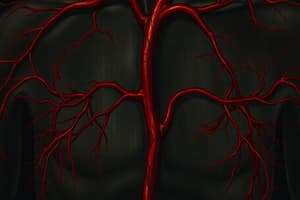Podcast
Questions and Answers
An open circulatory system is found in ______ and molluscs.
An open circulatory system is found in ______ and molluscs.
arthropods
Fishes have a ______-chambered heart consisting of an atrium and a ventricle.
Fishes have a ______-chambered heart consisting of an atrium and a ventricle.
2
Amphibians and most reptiles have a ______-chambered heart.
Amphibians and most reptiles have a ______-chambered heart.
3
In birds and mammals, the circulatory system is characterized by ______ circulation.
In birds and mammals, the circulatory system is characterized by ______ circulation.
The right atrium receives ______ blood from the body.
The right atrium receives ______ blood from the body.
The open circulatory system is present in ______ and molluscs.
The open circulatory system is present in ______ and molluscs.
All vertebrates possess a muscular ______ heart.
All vertebrates possess a muscular ______ heart.
Fishes have a ______-chambered heart with an atrium and a ventricle.
Fishes have a ______-chambered heart with an atrium and a ventricle.
In birds and mammals, oxygenated and deoxygenated blood is received by the left and right ______, respectively.
In birds and mammals, oxygenated and deoxygenated blood is received by the left and right ______, respectively.
Crocodiles, birds, and mammals possess a ______-chambered heart.
Crocodiles, birds, and mammals possess a ______-chambered heart.
Flashcards are hidden until you start studying
Study Notes
Circulatory Pathways
- Circulatory systems are classified into two types: open and closed.
- Open circulatory systems are found in arthropods and molluscs; blood flows through large vessels into open spaces or sinuses.
- Closed circulatory systems are present in annelids and chordates, where blood remains confined within a network of blood vessels, allowing for precise regulation of flow.
- All vertebrates possess a muscular chambered heart.
Heart Structure
- Fishes have a 2-chambered heart consisting of one atrium and one ventricle.
- Amphibians and most reptiles have a 3-chambered heart with two atria and one ventricle.
- Crocodiles, birds, and mammals possess a 4-chambered heart featuring two atria and two ventricles.
Blood Circulation Types
- In fish, the heart circulates deoxygenated blood to the gills for oxygenation, followed by distribution to the body (known as single circulation).
- Amphibians and reptiles mix oxygenated and deoxygenated blood in a single ventricle, leading to incomplete double circulation.
- Birds and mammals have complete double circulation where oxygenated blood from the left atrium and deoxygenated blood from the right atrium do not mix before being pumped out into the body.
Human Circulatory System
- The human heart features several important components, including:
- Vena cava: returns deoxygenated blood to the right atrium.
- Sino-atrial node: acts as the natural pacemaker, regulating heartbeats.
- Right atrium: receives deoxygenated blood from the body.
- Atrio-ventricular node: coordinates the electrical signals between atria and ventricles.
- Chordae tendineae: anchor the heart valves and prevent backflow of blood.
- Right ventricle: pumps deoxygenated blood to the lungs for oxygenation.
Studying That Suits You
Use AI to generate personalized quizzes and flashcards to suit your learning preferences.




